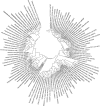Targeted antimicrobial therapy in the microbiome era
- PMID: 28609586
- PMCID: PMC5697594
- DOI: 10.1111/omi.12190
Targeted antimicrobial therapy in the microbiome era
Abstract
Even though the oral microbiome is one of the most complex sites on the body it is an excellent model for narrow-spectrum antimicrobial therapy. Current research indicates that disruption of the microbiome leads to a dysbiotic environment allowing for the overgrowth of pathogenic species and the onset of oral diseases. The gram-negative colonizer, Porphyromonas gingivalis has long been considered a key player in the initiation of periodontitis and Streptococcus mutans has been linked to dental caries. With antibiotic research still on the decline, new strategies are greatly needed to combat infectious diseases. By targeting key pathogens, it may be possible to treat oral infections while allowing for the recolonization of the beneficial, healthy flora. In this review, we examine unique strategies to specifically target periodontal pathogens and address what is needed for the success of these approaches in the microbiome era.
Keywords: antibiotic resistance; antibiotics; microbiome; oral health; selective drug target.
© 2017 The Authors. Molecular Oral Microbiology Published by John Wiley & Sons Ltd.
Figures


Similar articles
-
An insight into the last 5-year patents on Porphyromonas gingivalis and Streptococcus mutans, the pivotal pathogens in the oral cavity.Expert Opin Ther Pat. 2024 Jun;34(6):433-463. doi: 10.1080/13543776.2024.2349739. Epub 2024 May 20. Expert Opin Ther Pat. 2024. PMID: 38684444 Review.
-
The oral microbiome and the immunobiology of periodontal disease and caries.Immunol Lett. 2014 Dec;162(2 Pt A):22-38. doi: 10.1016/j.imlet.2014.08.017. Epub 2014 Nov 8. Immunol Lett. 2014. PMID: 25447398 Free PMC article. Review.
-
[Efficacy of taurine haloamines and chlorhexidine against selected oral microbiome species].Med Dosw Mikrobiol. 2013;65(3):187-96. Med Dosw Mikrobiol. 2013. PMID: 24432558 Polish.
-
Precision-guided antimicrobial peptide as a targeted modulator of human microbial ecology.Proc Natl Acad Sci U S A. 2015 Jun 16;112(24):7569-74. doi: 10.1073/pnas.1506207112. Epub 2015 Jun 1. Proc Natl Acad Sci U S A. 2015. PMID: 26034276 Free PMC article.
-
Novel Probiotic Mechanisms of the Oral Bacterium Streptococcus sp. A12 as Explored with Functional Genomics.Appl Environ Microbiol. 2019 Oct 16;85(21):e01335-19. doi: 10.1128/AEM.01335-19. Print 2019 Nov 1. Appl Environ Microbiol. 2019. PMID: 31420345 Free PMC article.
Cited by
-
A novel class of antimicrobial drugs selectively targets a Mycobacterium tuberculosis PE-PGRS protein.PLoS Biol. 2022 May 31;20(5):e3001648. doi: 10.1371/journal.pbio.3001648. eCollection 2022 May. PLoS Biol. 2022. PMID: 35639773 Free PMC article.
-
Candidal carriage in saliva and subgingival plaque among smokers and non-smokers with chronic periodontitis-a cross-sectional study.PeerJ. 2020 Jan 29;8:e8441. doi: 10.7717/peerj.8441. eCollection 2020. PeerJ. 2020. PMID: 32030324 Free PMC article.
-
Effect of a Short-Term Intervention with Lactobacillus salivarius Probiotic on Early Childhood Caries-An Open Label Randomized Controlled Trial.Int J Environ Res Public Health. 2022 Sep 29;19(19):12447. doi: 10.3390/ijerph191912447. Int J Environ Res Public Health. 2022. PMID: 36231747 Free PMC article. Clinical Trial.
-
Non-Surgical Periodontal Therapy with Adjunctive Amoxicillin/Metronidazole or Metronidazole When No Aggregatibacter actinomycetemcomitans Is Detected-A Randomized Clinical Trial.Antibiotics (Basel). 2020 Oct 9;9(10):686. doi: 10.3390/antibiotics9100686. Antibiotics (Basel). 2020. PMID: 33050325 Free PMC article.
-
ePath: an online database towards comprehensive essential gene annotation for prokaryotes.Sci Rep. 2019 Sep 10;9(1):12949. doi: 10.1038/s41598-019-49098-w. Sci Rep. 2019. PMID: 31506471 Free PMC article.
References
-
- Donne J. Meditation XVII In: Alford H, ed. The Works of John Donne, Vol. III. London: John W. Parker; 1839:574‐5.
Publication types
MeSH terms
Substances
Grants and funding
LinkOut - more resources
Full Text Sources
Other Literature Sources

